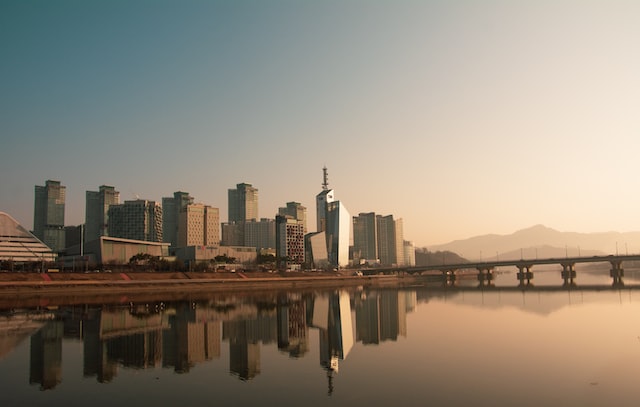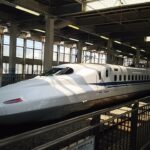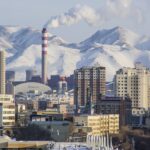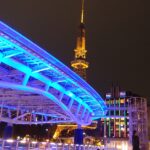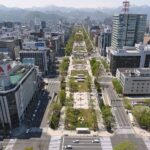South Korea’s thriving metropolis of Daejeon features a dependable public transportation infrastructure. There are three parts to it: the Daejeon Metro, the Daejeon City Bus, and the Daejeon Express Bus Terminal. The primary mode of public transportation in Daejeon is the Daejeon Metro, which has 25 stations and one line. The Daejeon City Bus, which has over 130 routes, is the second most popular mode of public transportation. From the Daejeon Express Bus Terminal, people can take buses to many places in South Korea. This is a popular way to get to work. In Daejeon, all forms of public transit are inexpensive, effective, and trustworthy.
Basic information about the Metro system in Daejeon
The Daejeon Metro is a quick way to get around the Daejeon Metropolitan Area in South Korea. It is the fourth-largest metro system in the nation, with one line totaling 28.3 kilometers (14 miles) of the track. The Daejeon Metropolitan Rapid Transit Corporation, which also offers a number of other services including ticketing, fare collection, and system maintenance, runs the metro. All of the stations have automatic ticket machines and fare gates, and contactless cards can be used to pay. For Daejeon residents, the metro is a practical and effective form of public transportation.
The lines of the Daejeon subway system
The Daejeon Metropolitan Subway Line 1 is a key transportation route in South Korea that goes through the city of Daejeon. The line was inaugurated in November 2011, and the Daejeon Metropolitan Rapid Transit Corporation is responsible for its operation. It links Panam Station in the northeast of the city with Banseok Station in the southwest. It is the only subway line in Daejeon and a vital connection between the city’s east and west sections.
Line 1 of the Daejeon Metro is a desirable option for commuters because of its many amenities. It boasts an automatic fare collection system, a dependable and efficient signaling system, and contemporary rolling stock. In addition, each vehicle is outfitted with enhanced safety features such as CCTV cameras and emergency buttons.
The route also provides a variety of services, such as the Express Train, which enables customers to travel between specified stations at a speedier rate. Moreover, there is the Airport Express Train, which operates between Banseok Station and the newly opened Cheongju International Airport.
The line gives convenient access to a number of Daejeon’s most popular sites, including the Hanbat Arboretum, Daejeon World Cup Stadium, and Daejeon Science Park. It is also conveniently connected to other important transportation hubs in the city, including the Daejeon High-Speed Rail Station, the Daejeon Bus Terminal, and the Seobu Intercity Bus Terminal.
Map of Daejeon Metro 2023 – Free Download in PDF
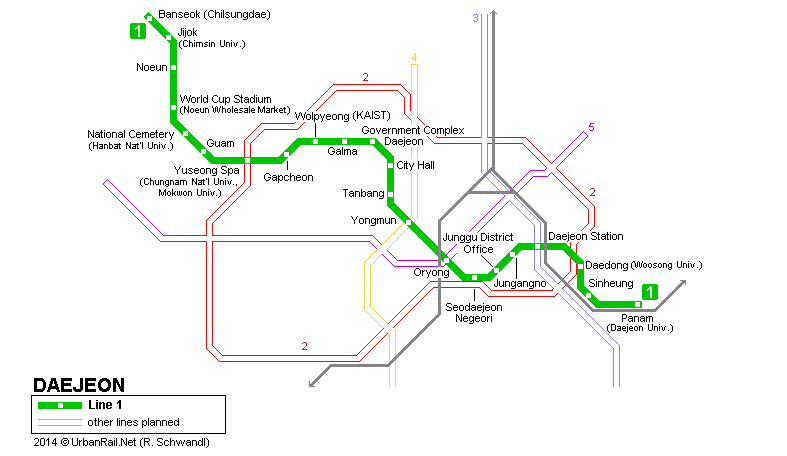
The Map of Daejeon Metro 2023 is an excellent tool for city exploration. The routes stops, and transfer locations of the city’s public transportation system are all included in the comprehensive overview. It is simple to view and print the map because it is available for free download in PDF format. With the help of this map, travelers may navigate the city quickly and effortlessly and make the most of everything Daejeon has to offer.
Public transport tickets in Daejeon – Best types for travelers & actual prices
If you’re looking for accessible and reasonably priced public transportation options in Daejeon, you’ve come to the right place. There are several different kinds of public transportation tickets available in Daejeon, each with distinct pricing structure and a set of advantages. We’ll provide you with a thorough summary of all the Daejeon public transportation tickets that are readily available in this page, along with details on costs, advantages, and other crucial details.
The subway is the most widely used mode of public transportation in Daejeon. For 1,200 won, one ride is good for up to two transfers. Additionally, there are passes that can be purchased for 30,000 won per month and allow for unlimited rides during that month. There are also unique cards available that offer savings on rides and other advantages.
Another well-liked mode of public transportation in Daejeon is the bus. A single ride costs 1,200 won, however those over 65 and those with impairments are eligible for discounts. For 25,000 won, monthly passes are also offered, which are good for unlimited rides throughout the month of purchase.
Although Daejeon’s taxis might be fairly pricey, people who need to go within the city have better options. For individuals who want to use cabs in the city, the Daejeon Taxi Card is an easy choice. The card, which offers savings on all taxi journeys, costs 10,000 won and is good for one year.
The Daejeon City Tour Bus is an excellent method to see the sites and attractions of the city. Tickets have a one-day validity period and cost 4,000 won. The bus makes stops at all of the city’s well-known sites as it travels in a circle.
In conclusion, Daejeon offers a wide variety of public transportation tickets, each with a distinct pricing and set of advantages. We trust that this article has given you all the knowledge you need to take full advantage of the city’s public transportation system.
Summary of fares for public transport in Daejeon
- Subway: 1,200 won for each journey with a maximum of two transfers; 30,000 won for unlimited rides per month.
- Bus: 1,200 Won each trip; reductions for the elderly and people with disabilities; 25,000 won for unlimited rides each month
- Daejeon Taxi Card for taxis (10,000 won, valid for one year)
- City Tour Bus: 4,000 won per ticket, good for one day; travels in a circle and stops at all of the city’s well-known landmarks.
Timetables & Schedules of the Daejeon Metro system
Every day of the week, from 5:30 a.m. to 11:30 p.m., the Daejeon Metro operates. The Blue Line and the Green Line are the two lines that make up the metro system. The Green Line connects Yuseong-gu Office Station to Gung-dong Station, while the Blue Line travels from Seo-Daejeon Station to Jungangno Station. Trains run every 5 to 7 minutes, and stations are placed between 0.7 and 2.2 kilometers apart. During peak hours, the metro system additionally provides an Express Line that travels from Seo-Daejeon Station to Yuseong-gu Office Station. For passengers with impairments, every station has wheelchairs, elevators, and escalators.
What Are Other Options For Public Transportation In Daejeon?
The metro system of public transportation is not the only choice for visitors and inhabitants of Daejeon, South Korea. There are other different solutions that can be used to easily navigate the city. Here are some of the other Daejeon public transit alternatives.
Bus: The entire city is served by the Daejeon Metropolitan Express Bus Corporation’s extensive bus network. Both the Corporation’s standard buses and privately rented buses that can be used for special occasions are available. The bus lines are well-marked, and the prices are fair.
Train: Those wishing to travel from Daejeon to other regions of South Korea should consider using the KTX high-speed train system. From Daejeon Station, trains travel to Seoul and other significant cities in the nation. The trip is swift and comfortable, and the prices are fair.
Taxi: Taking a taxi around Daejeon is easy and comfortable. The city is served by a wide range of cab services, and prices are fair. Taxi reservations can be made over the phone or online.
Renting a bicycle is an alternative for people who would rather go around the city on two wheels. There are several places in the city where you may rent bicycles, and the costs are fair. You can rent bicycles for a day or an hour.
These are only a few of Daejeon’s numerous public transit alternatives. Before determining which option is ideal for your needs, it is vital to weigh all of the options because each one has benefits and drawbacks.
How To Get From Cheongju International Airport (cjj) To The City Center With Public Transport?
Public transit choices have made it much simpler to go from Cheongju International Airport to the city core. Getting from the airport to the downtown area has become simple thanks to the array of buses and taxis that are readily available. Here is a map that will make it simple and quick for you to reach the city’s heart.
Take a taxi as your first option. Taxis are readily accessible outside the arrivals terminal, and depending on traffic, you may easily travel in around 25 minutes to the city centre. The starting fare is about 7,000 won.
The intercity bus is the second choice. Those trying to cut costs can consider this as a wonderful choice. The trip to the city centre on the bus, which runs every 10 minutes, takes around 45 minutes. The cost is between 1,800 and 2,500 won.
The Airport Limousine Bus is the third choice. Every 30 minutes, this bus leaves from the arrivals terminal and runs continuously from 6 am to 11 late. The trip takes about 45 minutes and makes several stops across the city core. The cost is between 3,000 and 3,500 won.
Taking the Airport Express Bus is the final alternative. For those seeking a straight path to the city centre, this is a fantastic choice. The bus leaves from the arrivals station and travels to downtown in about 30 minutes. The cost is between 3,000 and 3,500 won.
Whichever route you take, it’s now simpler than ever to go from Cheongju International Airport to the city centre. You can be confident that you will reach your location swiftly and effortlessly because there are so many various transportation options accessible.
What kind of sightseeing DO you have to see if you visit the Daejeon for THE first time?
One of the most significant cities in South Korea and a popular tourist destination is Daejeon. Daejeon is the ideal location to learn about the culture and history of South Korea due to its abundance of attractions and activities. Everyone can enjoy a trip to Daejeon, which offers everything from lovely parks to museums and historical places. Here are a few of Daejeon’s best tourist destinations.
The Daejeon Culture and Arts Center is one of Daejeon’s most popular tourist destinations. A variety of exhibitions, activities, and performances that examine South Korean history and culture may be found at the centre. In addition, the centre features a park, a library, and a theatre. The fascinating and interactive exhibitions provide visitors a thorough understanding of South Korean culture.
The Daejeon City Wall is another must-see destination in Daejeon. The largest city wall in South Korea, this one was constructed in the sixteenth century. Visitors can examine the wall and discover its significance to the city’s history. There are a number of historical structures and monuments along the wall that are worth visiting.
Another popular destination in Daejeon is the zoo. Numerous species of animals, including tigers, lions, and elephants, call the zoo home. The zoo’s botanical garden is open for visitors to explore and learn about the local flora. The zoo is a fantastic resource for finding out more about the fauna that calls South Korea home.
The Yuseong Hot Springs are a terrific destination for people seeking a more unwinding experience. Visitors may unwind and feel refreshed at the hot springs, which are renowned for their medicinal qualities. Additionally, Yuseong Park, a nearby park with a variety of outdoor activities and attractions, can be explored by visitors.
The Daejeon Eco Park is a fantastic location to visit, to sum up. Numerous eco-friendly activities and attractions may be found in this park. In addition to learning more about the environment, visitors can explore the park’s numerous paths, ponds, and gardens. A butterfly garden and a bird sanctuary are also included in the park.
These are a few of Daejeon’s most popular tourist destinations. When visiting Daejeon, there is plenty for everyone to enjoy, from cultural attractions to outdoor pursuits. Daejeon has plenty to offer everyone, whether they are seeking a cultural experience, a soothing hot spring, or a chance to discover the city’s natural beauties.
Summary of our tour guide for Daejeon
South Korea’s dynamic city of Daejeon is renowned for its upbeat vibe, extensive cultural heritage, and cutting-edge technology. It is a great tourist destination because it has many historical landmarks, parks, and markets. Daejeon has good public transportation, with a variety of buses, trains, and subway lines accessible. High-speed train service is also provided to the city, making it simple to travel to other regions of the nation. Daejeon is a great place to visit if you want to tour the nation because of its easy transportation options.
Top 5 FAQs and answers about Daejeon public transport?
- In Daejeon, what modes of transportation are available?
- The public transportation network of Daejeon consists of buses, subways, and taxis. With routes that go through the entire city, buses are the most widely used mode of transportation there. The city’s principal sections are all covered by the extensive subway system. There are also taxis, but they can be pricey.
- How much does a bus ride in Daejeon cost?
- Depending on the distance you are traveling, Daejeon bus fares vary. Typically, the fare for quick trips within the city is 1,000 won. The fare for lengthier trips can range from 1,500 to 4,000 won.
- How can I purchase a Daejeon subway ticket?
- At each station in Daejeon, there are ticket machines where you can buy subway tickets. Coins, banknotes, and credit cards are all accepted. Tickets may also be purchased at the station’s ticket counter.
- Can I acquire a bus pass for the buses in Daejeon?
- Yes, you may buy a bus pass to use the buses in Daejeon. The T-Money Card, the city’s bus pass, is accepted on all of the city’s buses. Almost all convenience stores and subway stations sell card.
- In Daejeon, is it safe to ride in a taxi?
- It’s generally safe to ride in a taxi in Daejeon. The meter calculates the fare automatically, and all drivers must have their licenses visible in the vehicle. To verify that your driver is a licensed professional, it is advised that you hail your taxi from a designated taxi stand.
Useful links

